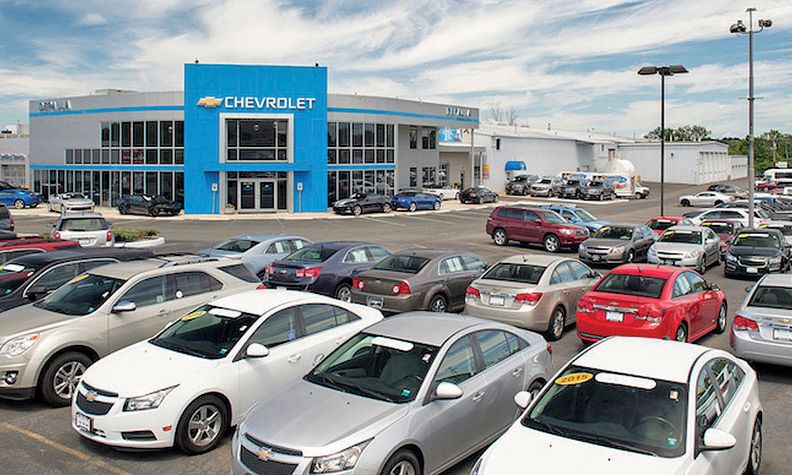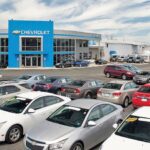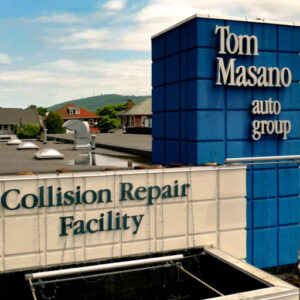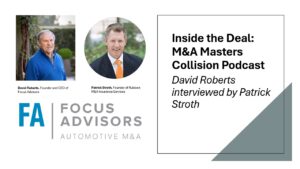Collision repair has often been called the ugly stepchild of a dealer organization. Some dealers, though, have made collision repair the stars of their organizations. Among the largest dealers, some have focused on providing large scale, fully equipped and staffed operations, able to offer insurance companies pricing and performance equal to many regional MSOs and consolidators.
Many dealers feel owning and managing their body shop makes sense to them: keeping customers within their ecosystem, from purchase to repairs to selling new and replacement vehicles, control of quality and timing of repairs, capturing parts sales and providing assurance that the customer never has to go anywhere else.
Some dealers have true market dominance with their brands and are able to attract and retain the best technicians, produce consistently high-quality work and deliver strong operating margins to their organizations.
But for many, the collision operation is something of a toothache: high technician turnover, an unattractive box at the back of the property, an uneven flow of vehicles, constant new investments in equipment and training, the pain of dealing with insurance companies. It’s not uncommon for that large piece of square footage to be the least profitable business for the dealership.
There are lots of reasons why even large dealers have decided to leave collision repair to MSOs and strong local providers including:
Responding to Insurer demands
Insurers are consolidating just like dealers and collision repairers. The largest insurers want networks of fully enabled and integrated providers across markets. They want discounts for volume and they want commitments on the usage of aftermarket parts.
Many dealers operating large, well-equipped single shops that primarily repair vehicles referred by the dealership are unable to satisfy these demands from insurers. Installing aftermarket parts, in particular, conflicts with both their systems and their commitments to their OE franchisors.
Conflicting systems
Dealers are often required use software mandated by their OEs, especially to manage inventory and order parts. Most of those systems don’t easily interface with software that is especially designed for collision repair. And to efficiently and profitably manage collision repairs, integrated estimating, repair planning, parts ordering and shop management systems are critical.
Lack of Scale
Most dealerships lack scale to effectively compete – both at the shop level and across a market. Individual shops that cannot generate at least $250,000 in monthly repair volume are increasingly not at scale for many reasons. Referrals from service writers to a shop has to provide this volume of business. One rule of thumb is that a service writer can refer about $10,000/mo worth of collision business, so a dealership has to employ 20+ service writers to generate the required volume.
Insurers want fewer points of contact in every market. They don’t want to have to interface with multiple individual shop managers. They would rather deal only with the manager of multiple shops. So a single shop that repairs vehicles for multiple dealer locations cannot meet this expectation.
Management and staff experience and redundancy
Shop managers are well compensated. Single location dealer shops with modest volumes are at a competitive disadvantage in recruiting, training and retaining them. MSO managers are focused on not just the correct repair processes and the staff that execute those repairs. They are experts at dealing with insurance companies, sublet vendors, paint distributors, KPI standards and a whole host of body shop specific criteria.
Redundancy may be the secret sauce though for MSOs. They are often part of a matrix management system where the absence of a tech or another manager or a painter doesn’t disrupt the flow of vehicles and cycle times. This kind of expertise and redundancy is much harder to come by, especially in a dealership with just one or two shops.
Technician Shortages and Work Volumes
Technicians, especially those trained and certified for higher end repairs, are in great demand. In fact, the estimated unfilled demand for skilled body techs is in the 10s of thousands nationally, leading to huge problems in attracting, training and retaining the skilled workforce required in a single facility or across many shops.
Flat rate technicians love to put in the hours. And if a dealer can’t provide enough cars to work on, even though the flat rate is generous, the total paycheck is less than working at a shop with consistent repair flows.
Large consolidators and regional MSOs continue to pay recruiting bonuses to attractive candidates and can almost guarantee a steady flow of work/income due to their DRP relationships. And they find many such candidates at dealerships.
Equipment and training investments
Dealers invest heavily in training and certifying their own technicians for repairs demanded by the OEs. Training and retaining those highly sought-after technicians is a problem for a dealer that can only offer work volumes that are determined by their own referrals. As a result, dealers often have to offer more compensation to such technicians, provide guarantees or regularly scheduled bonuses.
The constant requirement for newer, more sophisticated and more capable equipment is a drain on dealers’ capital budgets. With fewer vehicles over which to amortize these costs, some dealers risk falling behind the technology curve while the MSO has an entire organization with far more vehicles to repair using the same equipment.
Conflicting goals and confusing financial metrics
Most dealership cultures focus on moving product – vehicle and parts sales. Collision MSOs work off slim margins and their culture and focus is first on the quality of repairs and then on managing margins.
Dealers have multiple conflicts of interest when they operate a body shop as part of their organization. The parts department wants to maximize the sale of OE parts with their very substantial margins. The dealership invests heavily in inventory, sales people and systems that allow them to reach out to a larger market to sell these high margin parts as well.
While most dealers offer volume discounts to their larger customers in order to capture volume and lower their purchase costs from OEs, some sell those same parts to their own body shops and generate higher internal margins on parts sales. The dealer body shop manager isn’t happy that his operations are subsidizing the parts sales department.
Some dealers charge rent specifically against their body shops while others do not allocate rent to specific operations. If a body shop pays no rent for the space it occupies, it can inflate margins unrealistically.
Accounting for the body shop is a difficult exercise for many dealers because there are inter-company transfers which are not necessarily accounted for at the correct margins. These practices often disguising the true profitability of the dealer’s shop.
Clashing incentives
Often dealer estimators are trained and incented to maximize repair order revenues. Given the captive nature of many of these repairs, a dealer often has the option of telling an insurance company to “take it or leave it”. Insurers recognize this challenge and they work hard to have their insured go to non-dealer locations, especially large consolidators that give them significant concessions in return for volume. Dealer estimators have far less knowledge about the various DRP requirements even when the dealer is part of a DRP.
KPI management
Because many of the employees involved in collision repair at a dealership are focused on performing within the dealership incentives, they are less knowledgeable about the KPIs required by insurers and therefore received lower KPI scores. Length of rental, percentage usage of non-OEM parts, aftermarket parts, and other factors that determine a provider’s KPIs in the eyes of the insurer are not front of mind for many dealer personnel.
Some Dealers are Selling Their Body Shops
Increasingly, many dealers are looking to partner with or sell to strong local or national MSOs. Exiting the collision repair business can be a win-win for dealers – more rental income, more parts sales, fewer headaches, more satisfied customers, simpler accounting.
Prime example: A multi-location dealer sells to a strong local MSO
Recently we helped one of our clients acquire a large body shop from a high-quality dealer with significant revenues in its collision operation. The buyer was a very large, very well operated MSO with excellent DRPs. After the dealer sold the shop, he leased his facility at market rate to the MSO, agreed to sell parts to the MSO at his best customer discount. The MSO hired most of the dealer’s collision repair staff. The dealer sponsored the acquirer’s certifications for all of the dealer’s nameplates.
Results
Six months after the acquisition, the dealer is selling nearly twice as many parts to that same MSO. The MSO’s sales in that same location have doubled. The dealer is now receiving market rent for the shop. Cycle times on dealer referred repairs have improved by 35%. Additional dealer benefits have included fewer staffing challenges, lower investments in equipment and training, reduced occupancy costs and reduced insurance costs.
How did this happen?
Additional revenue from DRPs and increased capture of dealer referrals
Because of the MSO’s excellent DRP relationships, the volume of repairs in the former dealer shop now includes referrals from seven DRPs as well as an improved “capture rate” on dealer referrals. Together, the MSO and the dealer created SOPs and training for dealer staff that allowed them to capture more of the dealer customer vehicles.
OE warranty reimbursement to MSOs
MSOs are experts at dealing with the insurance company and OE bureaucracies including fully utilizing the OE portals. Reimbursements depend on understanding and fully complying with all OE requirements. Dealers no longer have to swallow the costs of parts and labor on certain warranty repairs when the responsibility shifts to the local MSO.
Reduced cycle times
With the increase in repair volume, the facility now has a smoother flow of vehicles. This has improved the cycle time on all repairs. Under the dealer operations, cycle times averaged 11-12 days while the MSO averaged 7-8 days across its multiple shops. Combining the dealer referrals into the flow of DRP referrals has improved the dealer-referred vehicle cycle times to the same system-wide performance as the MSO.
While length of rental is of secondary concern to many dealers, especially when the dealer is providing loaner vehicles – insurance companies are still measuring performance by the same standard.
Technicians are earning more because of this increased flow.
Together with the MSO, the dealer focused on making sure all repairable vehicles coming into the dealership were directed to the same MSO and not directed to shops with whom the dealership had a less integrated relationship.
Why can’t the dealer accomplish the same results?
Dealers are focused on sales and service, not on insurance relationships and establishing DRP relationships. Add to these, all of the challenges we described above, and you’ve got your answer.
Another overlooked benefit; Selling the body shop to a local MSO prior to or at the same time as selling the dealership may increase the equity value of the transaction.
When dealerships are sold, the body shop is many times just an afterthought, often not even broken out as a separate profit center. The typical dealership financial statement is more focused on service and parts sales and margins rather than body shop sales.
Some savvy sellers are now beginning to recognize that their body shops may in fact have more value as a separate transaction that doesn’t negatively impact the primary sale.
In summary, the benefits of selling a dealer shop to a strong MSO include:
- Market rent for standalone facility
- More gross margin if in-house facility is converted to service bays
- Higher volume parts sales because MSO directs more purchases to dealer
- Qualifications and certifications for technicians are assured by the MSO
- Better cycle times and higher customer satisfaction scores
- MSOs are magnets for new customers
- Increased equity value may result when sold separately from the primary dealership transaction.
Conclusion
Dealers have choices – to step up, invest and perform at the level of competitive consolidators and MSOs – or step back and realize improved operational and financial benefits by selling their shops.
Selling the body shop to the right buyer is one way to turn the ugly stepchild into a star performer. By focusing on what they do best while partnering with the strongest local MSOs, both dealers and MSOs win. And so do their customers!
We expect to see more sales of dealer body shops to strong local and regional MSOs
About Focus Advisors:
Focus Advisors is the collision industry’s leading M&A firm representing MSOs and single shops. We help entrepreneurs create and realize equity value by advising, raising capital and helping them sell their businesses. With 25 years in the industry, Managing Director David Roberts has led more than 40 transactions totaling over $500 million in transaction value and more than 300 collision repair shops. For a confidential discussion about your plans, go to our website https://focusadvisors.com/contact/ or contact David Roberts at david.roberts@focusadvisors.com or call 510-444-1173
Investment banking and securities offered through Independent Investment Bankers, member SIPC/FINRA. Focus Advisors and Independent Investment Bankers are not affiliated.






